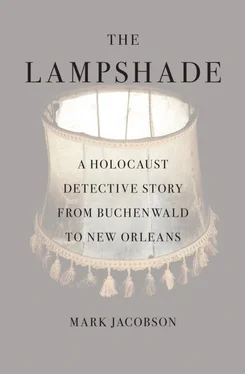For DNA report from Bode lab, see Appendix.
Accounts of Dave Dominici’s career as the New Orleans cemetery bandit can be found in many Times-Picayune articles, from his arrest in February 1998 until the trial in March 2000. Short of Dominici’s own accounts, probably the most interesting and idiosyncratic rendering of the story is in Lost Souls in the Cities of the Dead (1st Books Library, 2001), “a fictional police mystery novel” self-published by New Orleans Police Department detectives Lawrence Green and Frederick Morton, the arresting officers in the case. As Morton, who is now an NOPD captain in charge of the evidence and property room, told me, the book was started by his late partner, who saw it as “a chance to get a lot of things off his chest about the job and his relationship with his father.” When Green abandoned the project, Morton took over and wrote the second half, which contains the cemetery bust. “I really jazzed it up,” said Morton, an outgoing individual who promotes mixed martial arts cards on the side and maintains an abiding interest in New Orleans prosecutor Jim Garrison’s investigation into the Kennedy assassination. According to Morton, the cops “kind of felt sorry for Dominici,” who is called “D’Angelo” in Lost Souls in the Cities of the Dead. “He really got the short end of the stick in all that with the art dealers,” Morton said. “But what can you expect? Dominici is a total potatohead.”
Ideas expressed here owe a debt to Professor Lawrence Douglas’s article “The Shrunken Head of Buchenwald: Icons of Atrocity at Nuremberg.” Douglas’s discussion of the psychological motivation of the Nuremberg prosecutors is quite cogent. The article also includes the remarkable photo of Thomas Dodd holding a shrunken head in his hand, “like Hamlet contemplating the skull of Yorick.”
According to Israeli author Tom Segev, who was completing a book about Wiesenthal when I spoke to him in Jerusalem, the famous Nazi hunter later changed his mind on the soap issue. “He came to the conclusion it wasn’t so,” Segev said.
Buechner’s books Adolf Hitler and the Secrets of the Holy Lance (Thunderbird Press, 1988) and Hitler’s Ashes—Seeds of a New Reich (Thunderbird Press, 1989) were written with the pseudonymous “Captain Wilhelm Bernhart.” Buechner, a much-respected medical professor in New Orleans and a regular at many uptown society gatherings, claims “Bernhart,” whom he presents as “a former U-boat captain,” was privy to much of what went on between Hitler and Himmler regarding the Spear of Destiny. In Buechner’s account, the spear was recovered from beneath the South Pole ice in 1979 and now is back in Europe, in the possession of a mysterious organization called the Knights of the Holy Lance. Buechner has also advanced the theory that the ashes of Hitler and Eva Braun were similarly buried and retrieved from Antarctica.
Buechner’s work on the Dachau Massacre, which he claims to have witnessed, is far less fanciful. As recounted in his book Dachau: The Hour of the Avenger (Thunderbird Press, 1986), 520 German prisoners of war were murdered by American forces under the command of 1st Lt. Jack Bushyhead of the 3rd Battalion, 157th Infantry Regiment. Bushyhead, Buechner reports, was a “full-blooded Cherokee Indian” whose ancestors had been brutalized during the infamous “Trail of Tears,” a race-based death march in which thousands of Native Americans were forced from their homeland to reservations in Oklahoma. In murdering these Germans, Bushyhead was motivated, Buechner conjectures, by a kinship with the Jewish people who, like the Cherokee, had been “harassed and driven from country to country for thousands of years.” This idea is echoed in the recent Quentin Tarantino film Inglourious Basterds, in which Brad Pitt plays a Native American leading a platoon of Jews to take vengeance on the Nazis.
In his memoir, The Course of My Life, British prime minister Edward Heath writes of how as a young man he saw “tattooed human skins on lampshades” among the exhibits at Nuremberg, which is somewhat puzzling since no tattooed lampshades were introduced in evidence at the war crimes trials.
Some of the items on the Buchenwald Table were tested to determine their validity, others were not. Three “tattooed skin hides” were sent to the Army Section of Pathology in New York. A report dated May 25, 1945, signed by Major Reuben Cares, describes “Piece A” as measuring “13X13 cm., is transparent and shows a woman’s head in the center and a sailor with an anchor near the margin.” “Piece B,” a similar size, “is a tattoo of several anchors resting on an indefinite black mass. To the right of this mass is a man’s head.” “Piece C” is “truncated,” with the upper portion showing “two nipples” sixteen centimeters apart. A “black dragon, with fire coming from the mouth, measures 28 cm.” To the left of the dragon “is a man in a coat of mail, with a sword being apparently stuck in the dragon.” According to the report, “all three specimens are tattooed human skin.”
For the curious, Denier Bud’s work can be found in many web locales. Since these addresses tend to change from time to time, the entry of “holocaust denial videos” or “denier videos” into Google is a fairly reliable pathway. Presently Buchenwald: A Dumb Dumb Portrayal of Evil can be found at http://www.holocaustdenialvideos.com/buchenwald. For Nazi Shrunken Heads , see http://www.holocaustdenialvideos.com/nazishrunkenheads.
David Cole was widely attacked by militant Jewish groups following his appearance on the Phil Donahue Show . In an article entitled “David Cole: Monstrous Traitor,” the extremist Jewish Defense League, referring to Cole as a “low-life beast worse… than the Julius Streichers and Joseph Goebbels” and an “evil monster” who “does not deserve to live on this earth,” offered “a monetary reward” to anyone supplying his correct address. In 1998, supposedly in response to JDL pressure, Cole recanted his “revisionist” position and has rarely been heard from since. It is “intimidation” like this, according to Denier Bud, that has sapped much of the energy from the “revisionist” movement. But there are unmistakable signs that the “movement,” at least in its “scholarly” application, has been fading away since the Deborah Lipstadt—David Irving lawsuit case. In a January 9, 2009, article, Mark Weber, the longtime head of the Institute for Historical Review, publicly asked, “How Relevant Is Holocaust Revisionism?” Weber wrote: “Over the past ten years, sales of IHR books, discs, flyers and other items about Holocaust history have steadily declined, along with inquiries about Holocaust history and requests for interviews on this subject.” This was countered by a more than equal rise in sales of items dealing with “Jewish-Zionist power, the role of Jews in society, and so forth.” It was Weber’s conclusion that “In the real world struggle against Jewish-Zionist power, Holocaust revisionism has proved to be as much a hindrance as a help.” Asked if this signaled the end of formal Holocaust denial, Denier Bud said, “Well, maybe I’m going to be the last man standing.”
The Desire Projects, 262 low-rise structures on outlying terrain on the way to New Orleans East, were built in 1949 as part of a major urban renewal effort. Known as “the dirty D,” the area was crime-ridden even before the famous streetcar (which never reached the projects) stopped running in the middle 1950s. When the projects were torn down in 2003, the area was slated for a major housing upgrade, a plan that was derailed by Katrina. Some new housing has been built, but anyone exiting the I-10 at Louisa Street cannot fail to be struck by the abject desolation of the area. The fact that many of the unpaved streets have names like Abundance, Benefit, and Humanity only adds to the end-of-the-world squalor. The lamentable state of the old Desire area has often been mentioned as a cautionary note by activists who protested the demolition of New Orleans’s other projects after Katrina.
Читать дальше












